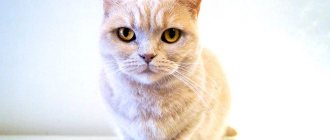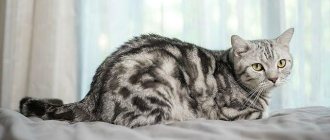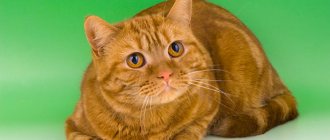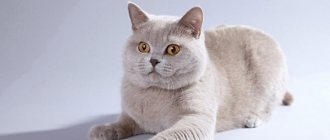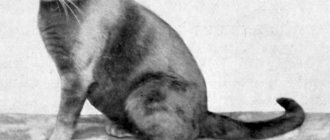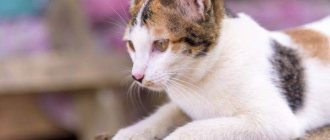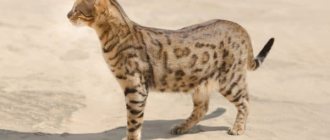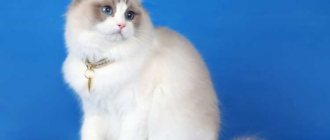There was a time when cream coloring in cats was considered a defect. Being too light, this color could not claim to be the standard of beauty among man's furry, mustachioed friends. But times change, and so does fashion. And now cream is not only no longer considered a flaw, this color has become popular, breeders have taken care to create such a shade in cats. Thus, the Persian breed of cats with a cream color was bred in the 20s of the last century.
The ideal cream color is associated with baked milk. It is this shade that one should strive for when breeding it from cats, although minor deviations are still allowed. In addition, the ideal color should be uniform in each hair from root to tip. Breeders also need to take this important parameter into account.
It is noteworthy that in the USA they prefer a less thick and saturated cream color tone than in the UK (here they will choose the golden mean). At the same time, experts and cat lovers around the world agree that a too dark tone is undesirable.
Photo of a cream British Shorthair
BLH e – longhaired cream
Characteristics of British kittens
Breeders select healthy individuals without genetic or other abnormalities, with a stable psyche and a friendly attitude towards people.
By purchasing an animal without documents, you risk purchasing a pet with diseases of various origins, weak immunity, or encountering unpredictable behavior. Because a breed is not only a name and appearance, but also a character.
British cats need constant attention, which is important for people who are outside the house all day. With a self-sufficient and independent character, British cats are not aggressive in critical situations and are not prone to attacking people.
From birth, the British are clean and almost immediately get used to the tray and scratching post.
As for the appearance of the British, they are easily recognizable among others. British cats are classic representatives of the semi-cobby type. This body type includes the following characteristics:
- strong and short wide-boned body;
- short rounded paws:
- powerful short neck;
- a large round head with cheeks that resemble jowls;
- erect ears with soft rounded tips;
- Their nose (British cats), wide from the bridge of the nose to the tip, has a depression;
- large round eyes;
- short tail with thickening at the base and rounding at the end.
Thus, the British is a collection of soft, rounded shapes. All physical parameters are strictly regulated, so deviations from them are considered a violation of the standards and result in the cat being rejected.
But in addition to their special memorable appearance, these cats have good hereditary characteristics. With proper care, they have virtually no health problems, and their life expectancy ranges from 12 to 20 years.
It is widely believed that a British cat can be distinguished from its relatives of another species by its eye color. This is not an exact sign, since a kitten’s eye color can only be fully determined by the first year of life.
In addition, eye color is tied to coat color and this must be taken into account when choosing a pet, as well as the fact that the presence or absence of certain traits is genetic.
Genes are divided into dominant and recessive, which means that no matter how beautiful blue eyes look, they are rare among British cats. After all, the gene for blue eyes is recessive, that is, it is suppressed by others.
Description of the breed
The physiology and appearance of the British were formed under high humidity in cold climates, therefore this breed has dense short hair that protects from cold and moisture.
Since British cats are excellent hunters, they are strong, hardy and unpretentious in food.
The breed standard describes the British as follows:
- The head has a wide skull and is round. The cheeks are developed, the cheekbones are wide, the muzzle is flattened and round.
- The nose is wide, straight and short.
- The ears are rounded and small, set wide and low.
- The eyes are round, at a great distance from each other, which exceeds the width of the nose.
- The body is massive, with a developed chest and good muscles.
- The limbs are powerful, but short. Paws are rounded.
- The tail is thick.
- Weight - Males weigh 10-13 kg, and females from 6 to 9 kg.
Wool protects cats well from the cold due to the developed undercoat. It does not adhere to the body, is thick and plush to the touch.
Sometimes there are longhaired British cats. A recessive gene is responsible for long fur, so a long-haired kitten cannot appear from ordinary parents.
People often confuse British and Scottish cats: some even seriously think that there is such a breed - the British Fold. The two different breeds should not be confused.
Differences in coat quality and color
There are two types of British cats: British Shorthair and British Longhair.
The classic color is blue (gray). Moreover, the color of the coat and undercoat must match.
Because of this feature, British cats are often confused with Russian blue cats. However, after carefully studying the standards of both breeds, it becomes clear that these are different animals.
Meanwhile, breeders are working to create new color options for cats without losing other standards of the species. Today there are already white, red and black colors, as well as many shades, for example, British reds are divided into red (bright red) and cream (peach).
British breed colors
In addition to all its numerous and undeniable advantages, the British cat breed is famous for its bright and generous palette of colors - almost their entire line is presented in the breed standard. Only the most popular and well-known colors among the British have up to six dozen! And if you count new, rare colors and variations, the total number will be up to two hundred.
Different colors may be present in one litter
But even this seemingly democratic approach to the variegated ribbon of colors is clearly regulated by the breed standard in each specific case. In the exhibition evaluation of an animal, there is a very large quota of expert evaluation specifically for color - according to the standards of various international felinological organizations, this ranges from 15 to 25 points.
British cats of all stripes - photo gallery
Blue (gray)
The blue color can be called classic for the British cat breed. Against the background of plush gray fur, huge eyes of all shades of amber look especially impressive.
At what age will the difference be clearly visible?
The characteristic appearance of the British breed distinguishes them from representatives of other breeds even at a very young age. However, only an adult, mature individual can be checked for compliance with the standards. Then we can say whether it is a purebred cat or a crossbreed.
Depending on the breed, the age at which a cat is considered an adult also varies. Bengal cats take 9 months to fully mature, Maine Coons take 2 years.
The British breed is considered mature at 12 months of age. Around this time, all processes associated with changes in coat and eye color are completed.
Nicknames for British fold cats
When choosing names for fluffy British kittens, consider several generally accepted rules:
- Any nickname must contain at least one hissing sound. With its help, a young kitten will easily remember its nickname and will be able to quickly respond to it.
- Try to come up with a name that ends with a vowel sound. It is best if it is the letter “i” or “a”.
- The cat's name should be as short as possible. 1-2 syllables are considered the best option.
Since lop-eared Britons are distinguished by unusual ears and generally funny doll-like faces, we suggest that when choosing a name, you should focus on external data.
For example, a British fold cat can proudly bear the English aristocratic name Henry, Henry, Donald, Alf, Stephen, William or Andrew. You can also choose a cool name for the boy, for example, Ushik or Ushastik. The names from children's cartoons, where the characters had funny ears, such as Mickey, Cheburakha, Elf, Shrek, Dumbo, Goofy sound interesting.
How to name a British and Scottish kitten >> How to name a kitten based on the length of its fur >>
A fold-eared girl can be called Sadness, Ushka or Fold. British cats have good royal and royal names, such as Emma, Matilda, Elizabeth. For girls with blue coat color, the names Dymka, Smokey, Sade or Malvina are perfect.
Is it possible to identify a Briton by his behavior?
There are also standards for the behavioral characteristics of a cat. The British are calm and clean pets, aristocrats from the cat world, so many people choose this breed due to its character.
These animals are not prone to hooliganism and find peaceful activities in the absence of their owners, for example, playing with specially designated objects or sleeping. They are easy to train to the litter tray and scratching post.
When you meet, don’t be shy about asking for documents and pedigree of the animals. Thanks to it, you will be able to understand what adult cats and cats from this litter will be like, because their external signs of kittens can change with age.
In a specialized club or nursery, future owners will be given a confirmation that the kitten belongs to their breed, a conclusion about its state of health and a certified birth certificate or a pedigree compiled on the basis of the metric, which will detail information about the ancestors up to the fourth generation. This is not cheap, nor is purchasing a purebred animal.
If it so happens that your pet is not a completely purebred representative of the breed, the swindlers can be held accountable by contacting law enforcement agencies and receive compensation in accordance with the procedure established by the court.
And the kitten you adopted is a living creature that loves you. He is already a new member of the family, a devoted friend and companion. Be responsible and merciful, do not abandon those you have tamed.
Basic moments
- This breed has been around the British for so long that in its homeland it is simply called shorthair.
- Recognizable features are a round muzzle, a stocky body and thick fur of a special texture, tactilely reminiscent of plush.
- Long before the appearance of the first “cat” organizations, the British Shorthair cat was valued not for its external qualities, but for its unsurpassed skill as a mouser.
- Animals openly show their affection for their owners, but do not like to sit on a person’s lap or hang in a person’s arms.
- They get along well with other pets (including dogs, rodents and birds), but do well as an only pet.
- Cats do not require complex and specific care.
- After reaching adulthood, the level of physical activity decreases significantly.
- Veterinarians call obesity the main danger facing British apartment dwellers.
- British Shorthairs are generally considered to be healthy cats, with an average lifespan of 12-17 years.
The British Shorthair cat is one of the breeds that nature has worked on much longer than humans. As a result, we have a physically developed, harmoniously built animal with a light, easy-going character. Living together with him will not cause the owners much trouble. British cats are attractive due to their calm disposition, bordering on phlegmaticity, good manners and incredibly beautiful, pleasant to the touch plush fur. In the famous book “Alice in Wonderland” Lewis Carroll forever immortalized this breed in the image of the Cheshire cat.
Character
All representatives of the Persian breed, be it a Persian tortoiseshell, white or peach cat, are united by a peaceful and docile character. It takes a lot of effort to get a cat of this breed interested in something. The Persians' favorite pastime is lounging on a soft sofa or armchair. In homes where there is a fireplace, these animals are happy to lie on the rug next to it.
A kitten of this breed becomes very attached to its owner and subsequently values his attention. It is also known that representatives of this breed are afraid of judgment from the owner. These cats will have no problem learning to perform simple exercises during training. They easily get used to the routine in the house. These animals treat guests without aggression, with some curiosity.
The breed gets along well with other animals, be it a dog, a parrot or another cat. Usually Persians do not bother the owner and other inhabitants of the apartment with persistent meowing.
In folk medicine, it is widely believed that cats are able to treat their owners from diseases. This also applies to the Persian breed. Thus, it is believed that animals are able to smooth out unpleasant sensations during the owner’s illness with their rumbling. Persian cats are able to relieve pain during exacerbations of back diseases, in particular osteochondrosis.
History of the British Shorthair cat
Over the years, it is impossible to find documentary evidence of the first appearance of cats in the British Isles. However, researchers suggest that domesticated animals were brought there by Roman conquerors. The legionnaires, of course, did not keep them as furry friends - someone needed to protect the provisions in the holds from the attacks of ship rats. True, those rodent hunters bore little resemblance to today’s round-faced and well-built individuals; their physique was closer to the graceful and long-legged Egyptian animals.
But the free feline nature took its toll - and some of the small predators brought by the invaders moved from the decks to solid ground, and there, over time, they met wild relatives who enriched the gene pool.
For centuries, short-haired purrs lived side by side with peasants, receiving a little milk and a roof over their heads for their contribution to the fight against mice. No one, of course, cared about selecting kittens based on coat color, ear shape and tail length, so the appearance of the breed was formed naturally. It must be said that the attitude towards these cute creatures was often not just indifferent, but even hostile, while dogs were considered true friends, worthy of sugar bones and a place by the fireplace.
It was only in the second half of the 19th century that the British realized that their pets had many unique and attractive characteristics that needed to be strengthened and developed. In the Victorian era, being the owner of a cat became not shameful even for a representative of high society. The popularity of mustachios was greatly promoted by the original and witty drawings of the famous English artist Louis Wain. A talented graphic artist created a whole universe in which anthropomorphic cats play golf and bridge, go on picnics, read newspapers, have Christmas parties, sledding, play music, relax on the beach... In addition, already at the dawn of the development of photography, enthusiasts of the new art realized that how beautiful furry creatures look in the frame. In a word, the ice was broken.
On July 13, 1871, the world's first professionally organized cat show was held in London with great success. Harrison Ware, with the support of the then manager of Crystal Palace, invited 170 event participants and their owners to the former World's Fair pavilion. He also developed competition regulations, a system for awarding points and determining winners in various categories. Visitors were surprised to discover that well-groomed and well-fed cats not only look charming, but also behave like real aristocrats. The next morning, the front pages of the capital's respected newspapers were adorned with portraits of the award winners, including 14-year-old blue tabby Old Lady. By the way, it was the blue color that was considered the only correct color for British shorthairs in the last century.
After the exhibition, the once unnoticed street animals gained popularity. A breed standard, amateur clubs and the first kennels appeared. However, in the last decade of the 19th century, Great Britain was overwhelmed by the pan-European fashion for Persian cats. On this wave, during the First World War, breeders introduced the British Longhair. Experts still cannot say with certainty whether a fixed spontaneous mutation took place or whether the breeders simply used “foreign” genes in breeding.
With the outbreak of World War II, the already unfavorable situation for shorthairs became truly catastrophic. Animals, like people, died en masse under German bombing, and the policy of food austerity left no chance of maintaining nurseries. In the post-war years, the few surviving British cats were actively crossed with representatives of various breeds to produce offspring: Russian Blue, Chartreux, Persian. Due to the large percentage of mixed blood, the breed was classified as a hybrid for a long time and therefore was not registered by leading regional and world felinological organizations. The American Cat Association distinguished American Shorthairs from Old World cats in 1967, listing the latter under the name "British Blue." The ACFA accepted the breed in 1970, and The Cat Fanciers' Association (CFA) recognized the breed in 1980.
The British Fold cat is an extraordinary beauty
Greetings, dear readers! Despite the fact that professional breeders claim that officially there is no such breed as the British Fold cat, backing up these statements with facts, in the international system there are 2 varieties of British cats: shorthaired and longhaired.
Only Scottish cats have fold ears.
It is not customary for breeders to cross breeds with each other, but people have the right to cross a British cat with a Scottish cat and get a British Fold.
Tortoiseshell color
tortoiseshell cat
- Chocolate and red shades, when combined, form a fairly intense palette. In this case, both shades should be presented in approximately equal proportions. It is highly desirable that they intersect in the area of the paws and muzzle. According to experts, completely tortoiseshell pigmentation of this type is formed in animals at about one year of age.
- The black and red shorthaired tortoiseshell cat immediately impresses with its brightness - in this case, contrast is the main advantage. Sometimes you get the feeling that there is a creamy tone, but in fact this effect is given by the red pigment.
- Cinnamon-red tortoiseshell variety is a milder version of the previous point. Cinnamon - the tone of cinnamon - does not contrast with red, but complements it favorably and makes the overall palette warm. This kind of fur is rare, so it is highly valued by breeders.
- Tortoiseshell point color is an interesting option. It is one of the most popular today. A kind of British Siamese cat and a turtle at the same time. In this case, the body is lighter, and the ears, muzzle, tail and paws are dark. What is extremely undesirable to allow are large, clearly defined black and red spots.
- The combination of blue and cream looks quite gentle, harmonious, and elegant. Unlike previous colors, this one is not contrasting. It is distributed quite evenly throughout the body of a short-haired cat. Nothing should disturb such harmony - neither any drawings, nor individual white hairs.
- The ticked turtle is not a defect. Multi-colored hairs can create ripples on any shade of fur. Gray can turn into silver with frost, regular chocolate can turn into “chocolate with milk”.
What colors can a British Fold cat have?
If you look closely at the photos of these pets, you can conclude that blue is the most popular color among them. You can also find red, chocolate, grey, black, brown and even lilac Britons. A white or peach-colored British cat is quite rare to find.
Next is a photo of a brown British cat, which shows that the pet’s fur is quite smooth and short, resembling velvet in appearance.
CREAM BRITISH: COLOR STANDARD
Cream cats are often called Beige Britons or Peach Britons. The hairs of this color are dyed to the roots, the tone of the coat is light cream, the same in tone throughout the entire body of the animal. A cream-colored British cat should not have tabby markings: spots, stripes, tail rings, specks, etc. The nose and paw pads are pink.
British cream colored eyes can be of the following colors:
The color of a British cream cat should not contain pigmentation of the nose, paw pads, and the coat color should not have undyed white hairs. These shortcomings are rejected.
Description of the character of British Fold cats
Many people, before letting a pet into their home and family, try to learn as much as possible about the description of the breed and the character of the future household member. This is a very wise decision, since many cat breeds are characterized by excessive independence, lack of attachment to their owners, and are not affectionate or friendly.
All of the above has nothing to do with British kittens; they are very affectionate and friendly, they love to be stroked and “squeezed”. The British are ideal for those families with small children, they get along well with them, take part in their games with pleasure, and do not offend them, provided that they are treated the same way.
Little kittens are easy to train, they grow quickly and learn from their mother cat how to groom themselves and go to the litter box. Even those kids who grow up without a mother quickly get used to doing their chores where they should be, without burdening their owners with cleaning up after them.
But, like most cats, the British are also characterized by pride and stubbornness; if the pet does not want to sit on your lap at the moment, you cannot restrain it. These pets rarely meow, hinting to their owners that they should be fed; they would rather sit near an empty cup, pretending that their owner is very irresponsible.
The nature of these pets is such that if you love them and show them due respect, they will repay their owners in kind. Check them out in this video:
Cream color genetics
The cream color in British Shorthair and Longhair cats is achieved by lightening the red, which is only possible when there is a lightening gene. A representative of the monochromatic group, today this color is rarely obtained by breeders. The right peach shade has a clean structure, rich shade in pastel colors. At the same time, the manifestation of a tabby pattern in the color of kittens, and residual tabby markings in adults, is not considered a defect.
BLH e – longhaired cream British kitten
SFS e - scottish fold - shorthaired cream Scottish kitten
If we delve deeper into genetics, the formation of cream color occurs as a result of the distribution of pheomelanin (yellow pigment granules) under the influence of the dilution gene (dd). Accordingly, the same rules apply for cream and red. British female kittens have the XX chromosome, boys - XY, these chromosomes are the determining factor for the formation of color.
Image – Genetics of cream color
In the genotype of cream females there are two genes for red color (O), localized on the X chromosome. Males have only one such gene. Each gene occupies a dominant (O) or recessive (o) position. Thus, female kittens with the combination “OO” will certainly be born red, with “oo” the offspring will not be red (black), and in the case of the “Oo” option, tortoiseshell-colored females will be born. Male kittens, due to the presence of only one X chromosome, can only be red and black. Male animals will inherit the color gene from their mother. So, if “OO”, then the cat will be red in color. With the second option “oo” the male kitten will be born black. And in the case of the third “Oo” scenario, the kitten will inherit the red color from its mother.
Table - color of kittens
According to statistics, more males are born with cream color than females. When red, cream and all tortoiseshell variations of cats are crossed with animals of black and lightened variations, it is the cats that can be born cream. If you want to get cream kittens from your BRI e, then the partner must also be BRI e. However, in this situation, kittens may develop a pronounced pattern. If the male is red and heterozygous, in theory only half of the offspring will get cream, but in practice, any of the options can happen. It makes no sense to select partners of other colors, since BRI e female kittens will not be obtained. Only male kittens can be born with this noble shade.
In this rule, as in any other, an exception is possible, although it happens extremely rarely. For example, in a blue-cream cat, for some reason, the activity of all X chromosomes with the non-red gene (o) has been lost. Externally, the female will be cream-colored, and to check the genotype, you will need to resort to testing crossing.
Another gene is involved in the formation of color in kittens - the D gene (Dilutor, diluent). In the genotype - this gene affects lightening and can be either dominant D (no lightening) or recessive dd.
Breeders must take into account that the non-agouti (a) gene in red and cream cats does not affect the formation of the coat. Despite the fact that these colors are included in the category of “solid”, the color is unlikely to be perfectly uniform; rather, it will appear in spots, streaks and stripes. Meanwhile, it is possible to minimize the appearance of tabi patterns. Against a light background, areas of a different shade do not stand out as much as red ones. In addition, long hair can save breeders, thanks to which the pattern will be less concentrated. That is why long-haired light-colored Persian cats are the owners of an almost perfect cream shade. But it is almost impossible to remove the correct “cream” on cats with short hair. It is also necessary to take into account the fact that when replacing the undercoat with guard hair, the overall color may become darker. So breeders should not rejoice if the kitten is very light cream.
The offspring inherits color exclusively from the parents. Thus, a male and female BRI e can only produce cream kittens. And a pair of red (BRI d) kittens can be born cream only when both parents have the lightening gene (d).
Each breed of animal is determined by specific features in appearance and character traits that are unique to it - this is called the breed standard, which must be recognized by various organizations of felinologists (TICA, FIFe, WCF, CFA, IFA, ICU, WACC, etc.) for each of them own rules of recognition. All purebred cats are given pedigrees.
One of the most amazing and mysterious breeds is the Maine Coon - a gentle giant with a serious look. These creatures are called “indoor lynxes,” which is not surprising, because... they are one of the largest domestic cats.
All over the world this breed is called “Scottish Fold”, but we are more accustomed to calling these cute cats “Scottish Fold”. Their “cute” appearance will not leave anyone indifferent - you immediately want to pick up such a creature and cuddle it.
Millions of people around the world cannot imagine their existence without such “plush” bundles of happiness. These aristocratic, friendly, charismatic and very clean pets have long been one of the most popular cat breeds on the planet.
Bengal cats are incredibly beautiful animals that combine the spectacular appearance of wild predators and the docile nature of pets. Well, the main “feature” of these creatures is their “leopard color,” which is why they are called “domestic leopards.”
Siamese - graceful oriental beauties and beauties (who managed to preserve their roots almost in their original form) stand out for their special grace, temperamental character and a certain diminutiveness.
Among the many breeds, there is one endowed with incredible elegance and grace - this is the Abyssinian cat - an intelligent, flexible and dexterous creature. There is a certain mystery and special sophistication in her, and her appearance is called “divine.”
This breed is distinguished by its special silver-blue color and piercing green eyes. Russian blue cats are “real noblewomen.” These are graceful and mysterious creatures, delighting their owners with a playful but obedient disposition.
Siberian cats are considered real Russian beauties for their expressive eyes, chic “fur coat” and friendly character. They have long won the hearts of many cat lovers... a very long time ago - the first mentions of them are found in the 16th century.
The Oriental cat, at first glance, is impressive with its ears (in comparison with the body and head, they seem simply huge). This is a wonderful friend and you cannot betray him (the cat will not understand if you give it to another person).
Charming “Siberians” with a “Siamese” color, a chic hypoallergenic “fur coat” and an easy-going disposition are the pride of Russian felinologists from the banks of the Neva... Dmitry Medvedev got himself a kitten of this particular breed, and Vladimir Putin gave one to the Prime Minister of Japan.
Persians or Persian cats do not leave indifferent almost all lovers of furry pets. These magnificent animals with an unsurpassed appearance will become wonderful companions for their owners. And Persian kittens, thanks to their cheerfulness and playful disposition, can cheer up their owner in a matter of seconds.
The Persian breed is one of the most common and famous. If you ask a random passerby on the street to name the three most famous breeds of cats, you can hear in his answer about Persian cats.
How to care for a British Fold cat
Many future owners of this pet have questions about the care and maintenance of these cats. Buying a pet of this breed will be very successful for its future owners, since kittens from infancy begin to take care of themselves on their own, this applies to going to the toilet, cleaning their paws and other parts of the body with the help of a tongue. But, of course, there are also places that are difficult for the kitten to clean on his own, then the owner should help him.
Basic care for this breed is as follows:
- Cleaning your pet's ears of wax a couple of times a month will be enough.
- If the cat does not grind her claws down on a special scratching post, then you need to carefully trim them once a month, you can do this at the veterinary clinic.
- Your pet needs to wash its eyes once a week with a damp cloth or cotton pad soaked in warm water.
Also, the British need to be brushed regularly so that their coat does not become matted, is shiny and well-groomed. There is no need to wash your domestic cat often, just a couple of times a year is enough; for this you need to purchase a special shampoo at the veterinary pharmacy; under no circumstances should you wash your pet with ordinary gels and other products intended for people.
What to feed the British
Also, many questions arise about the care and feeding of British fold cats and cats. It should be understood that the beautiful appearance and health of a pet directly depends on what it eats.
The British can be fed in two ways, that is, either give them natural food or ready-made balanced food. It is very important not to mix these two methods of feeding your pet, otherwise you can create problems with the gastrointestinal tract.
If time and finances allow you to feed your cat natural food, then its diet should include the following products:
- Boiled meat (lamb, beef, chicken). Turkey can be fed raw. Fatty meats (pork, goose, duck) are prohibited.
- Vegetables, cereals.
- Cottage cheese, milk, cheese, yogurt, fermented baked milk or kefir.
Also, in addition to these products, kittens and adult cats need vitamin complexes specially developed for them, which can be purchased at veterinary pharmacies; they must be given in accordance with the attached instructions.
If there is not much time to prepare food for your pet, then it is better to organize his table using ready-made food. Only high-quality food is suitable for feeding this breed, ranging from premium class and higher; cheap brands of food are not absorbed by the pet’s body and can cause significant harm to its health. Also, the British should have constant access to clean water, preferably bottled.
Health features of British fold cats and cats
Before asking the breeder about the price of a pet, future pet owners should have an idea about the characteristics of its health and know its more vulnerable areas.
Due to the fact that the breed is artificial and cats of different breeds are crossed, very often problems arise with the formation of bones in kittens. The spine and fingers are especially at risk, as large, inert growths can grow on them, preventing the cat from walking.
This problem can only be solved surgically. To reduce the risk of its occurrence, it is better to organize the process of mating Scottish and British breeds under the supervision of an experienced breeder and veterinarian.
In addition, these pets may suffer from the following genetic diseases:
- Worm infestation.
- Obesity. British cats are prone to obesity, so you should monitor your pet's activity and not overfeed it.
- Hypertrophic cardiomyopathy. The disease develops after the pet reaches the age of 1 year, so during this period it is very important to give him an ultrasound.
Funny nicknames
Finding a name for a small pet is a fun process that will engage everyone in the family.
Everyone wants a kitten to have a unique nickname that could convey all its external and internal qualities.
For this reason, you can resort to cool and funny names that will give the animal brightness and mystery.
Important! Among the cool names for animals you can find many strange and unusual ones.
A suitable option would be names starting with the letters m - Masyanya, Murzik, Mukha, Malina, Mashka, Mikha, Murzya, Migera.
Other nicknames may be suitable for cats:
The following cool names are suitable for cats:
Choosing a name for a kitten is a ceremony for many, especially if the pet is purebred and has a pedigree.
It is important to choose a nickname that conveys the character and external qualities of the animal.
Moreover, on the Internet there are beautiful, funny, cool, original and simple names for cats.
Useful video
You still don’t know what to name the kitten that just moved into your home? You can select several suitable options if you narrow your search area and choose exclusively from thematic areas that pique your interest. Then it will be necessary to discuss the versions with your family and settle on a nickname that is attractive to everyone.
What can you name a kitten?
Interesting and unusual names for kittens can be found in the literature. Think about your favorite or just colorful characters from books that are suitable to name a kitten. Interesting ideas can be found in both classic cinema and blockbusters. Comics and computer games provide great scope for imagination. You should focus on the breed; a luxurious cat can be called Churchill, and an elegant cat can be called Godiva. Try it, and you will understand that finding the answer to the question of what to name your kitten is not only simple, but also fun if you get involved:
- Trips.
- Gastronomy.
- Mythology.
- Cartoons.
- Fairy tales.
- Blockbusters.
- Other areas of your interests.
Names for boy kittens
You have just adopted a small male into your family, so this is a good choice, since cats have an easy-going character. When choosing what to name a boy kitten, look at the nicknames listed below:
Which nickname matches your pet can be understood intuitively. It is advisable to select names for boy kittens (Russian nicknames) with hissing notes, since furry cats love sounds similar to mouse rustling and remember them well. The nicknames Lusha, Yasha, Zhuzha are perfect. The nickname Syom Syomych sounds funny in relation to the baby. When the kitten grows up, the name will acquire a connotation of respectability.
Nicknames for girl kittens
As soon as you adopt a cat, you immediately want to choose a name from the list of lucky names for kittens in order to further protect the plush miracle. But you should wait a little so that the pet’s character becomes more obvious and then you can choose a nickname suitable for naming the kitten a girl. Check out the list first:
The question of how to choose a name for a girl kitten should also concern the animal’s guardian from the point of view of the speed of the pet’s assimilation of sounds. The female will respond best to Margosha or any other word with a hissing sound. The cat must understand that the name is hers, and not any of the household members or other animals. In this regard, the original word will be preferable.
Cost of British visloushek
Fold cats are not purebred British, so you can get a cute kitten at a very reasonable price. Photos and prices of pets can be found from people who breed such kittens.
A British Fold kitten can be obtained at a price ranging from 2,000 rubles to 5,000-6,000, but in this case, most likely there will be no documents for it, including a vaccination card. You can even get such a kitten for free on the market or through free advertisements.
A cat that has documents and vaccinations may cost more, the price for them reaches 14,000-15,000 rubles.
If you cross a British and a Scotsman
Representatives of the cat family are not particularly scrupulous from a moral point of view, and therefore they can end up with any random breed. But owners must carefully monitor their purebred murks and, above all, worry about their health.
Illiterate mating of a Briton with a Scot can lead to skeletal deformities in future kittens or “reward” them with hereditary diseases, even if mom and dad are completely healthy. Crossing a British cat with a Scottish fold cat is allowed only in a professional cattery. There, an experienced breeder who is well acquainted with the anatomy of cats and the structure of their skeletons will select a pair. In addition, the entire process will be controlled by the club's breeding commission.
Mating, pregnancy, birth of British breed cats >>
When trying to get a mix of British and Scots, you should remember that the British breed is a closed one. This means that these pets can only be brought together with their own kind. Scots are allowed to knit according to the principle of Scottish Straight + Scottish Fold. It is extremely rare that Scottish cats are crossed with British cats, only if there is a need to breed some color or improve the bone structure. At the same time, the WCF system has prohibited any interbreed crosses since 2004.
However, when these animals are mated, the result is a rather cute Scottish or British fold.
